Charles E W Bean, Diaries, AWM38 3DRL 606/251/1 - 1915 - 1936 - Part 28
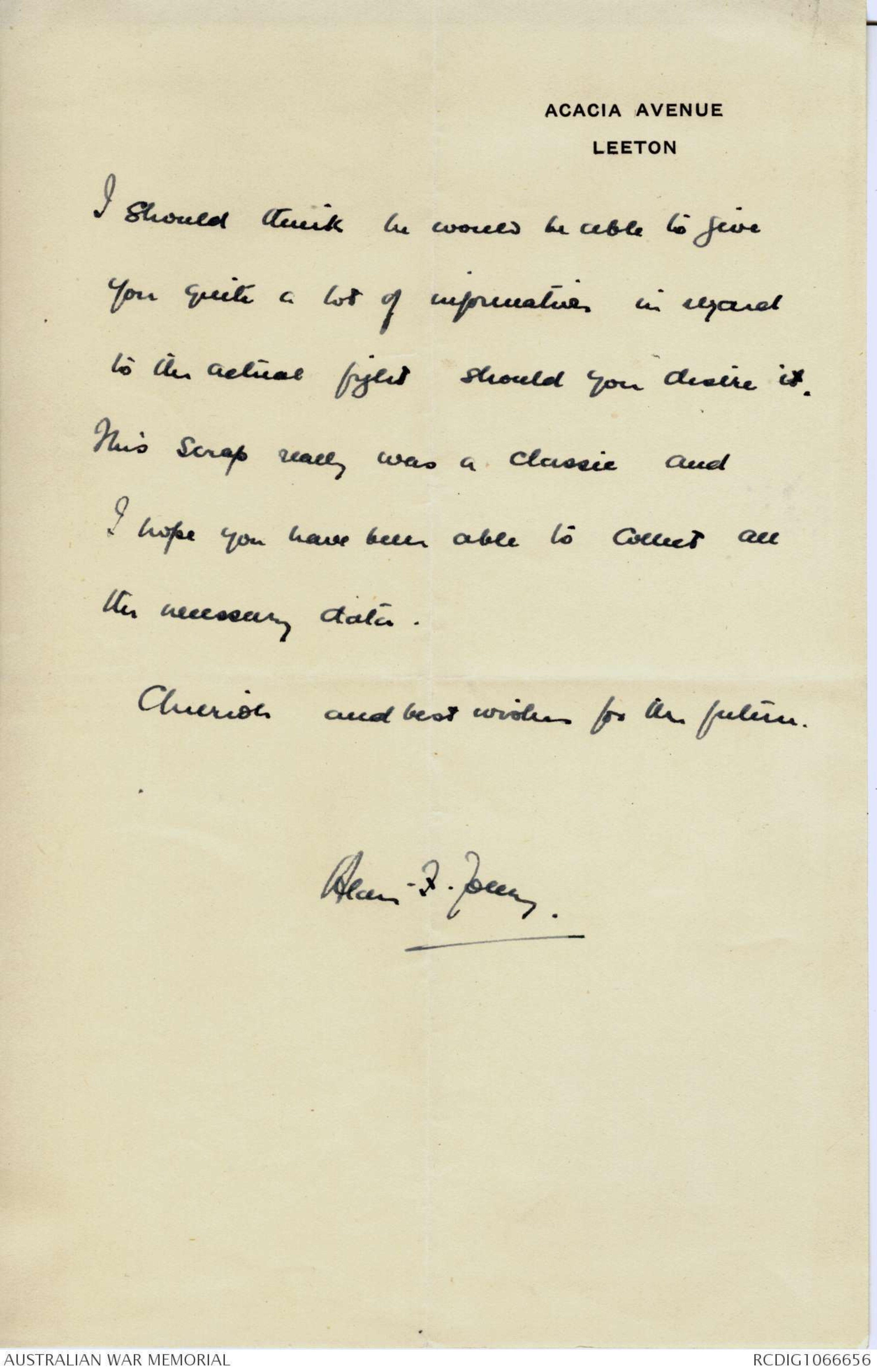
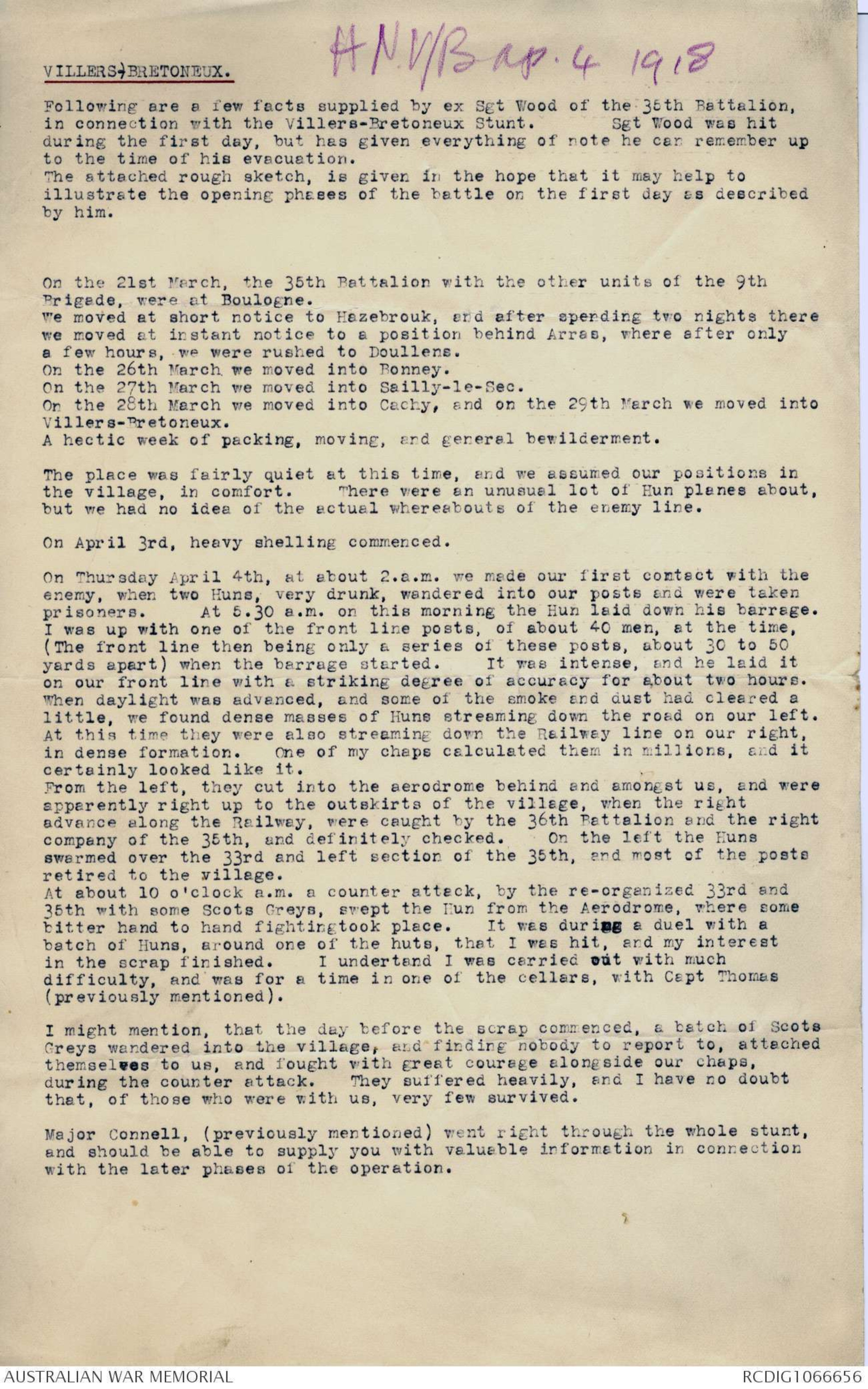
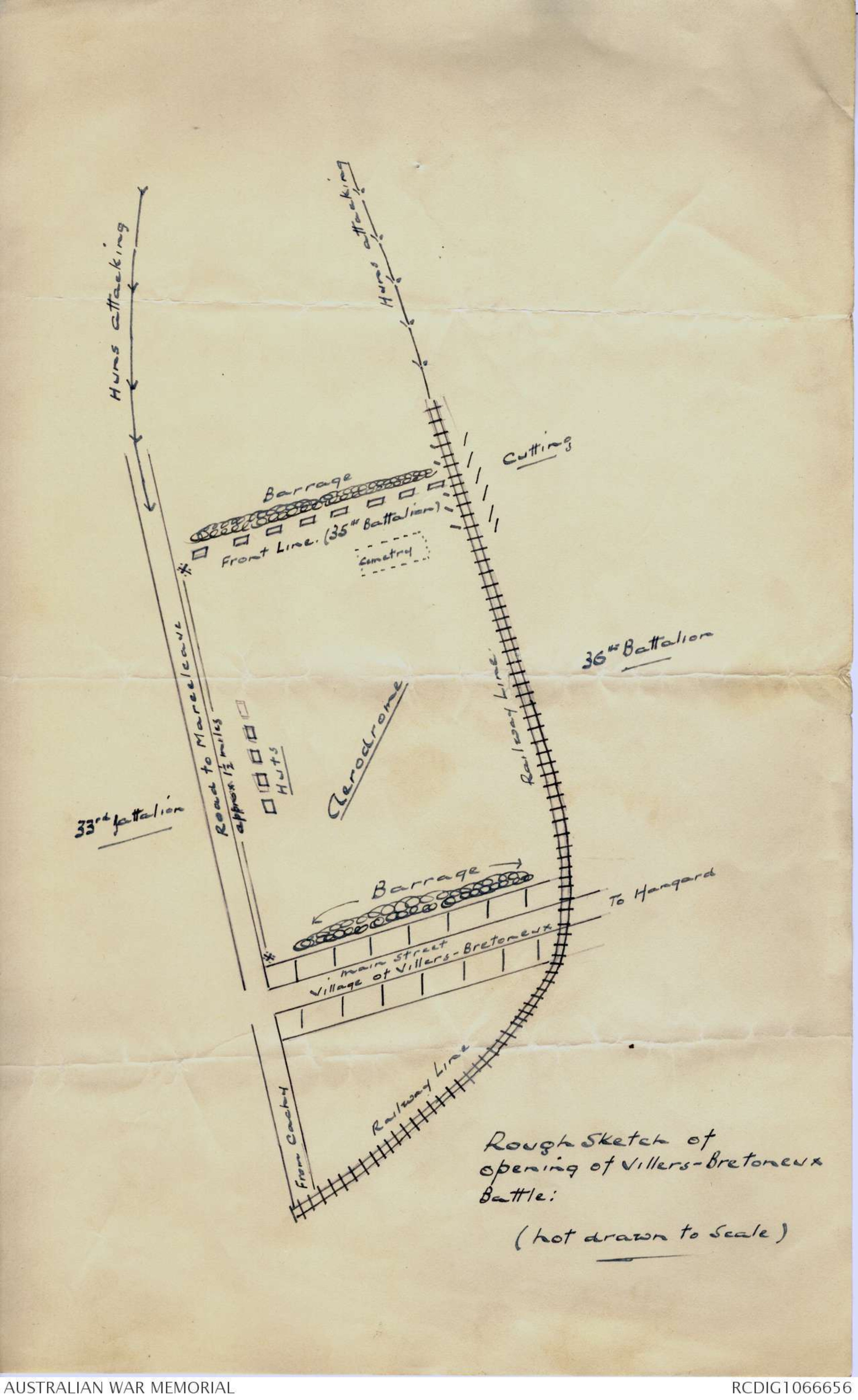

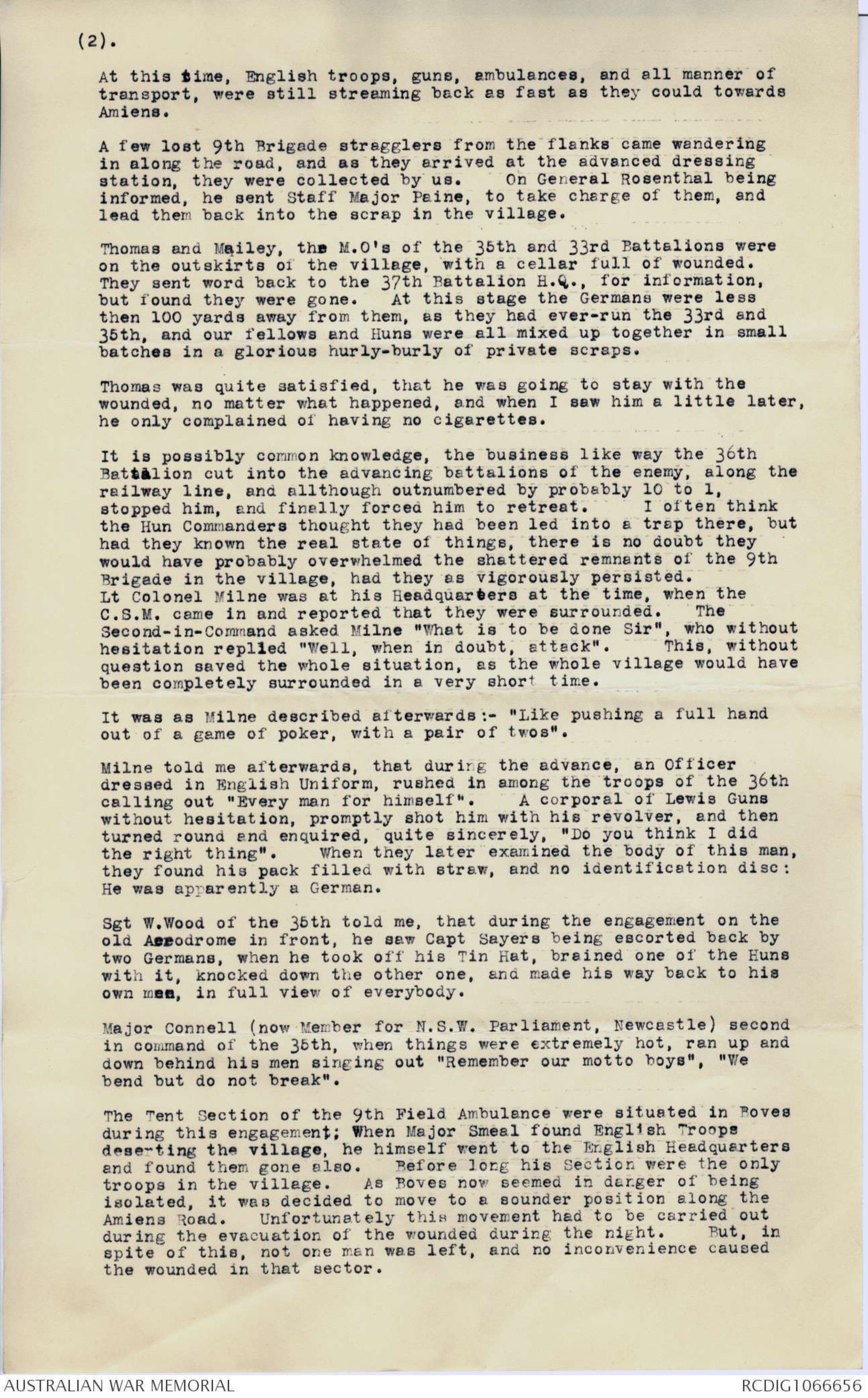
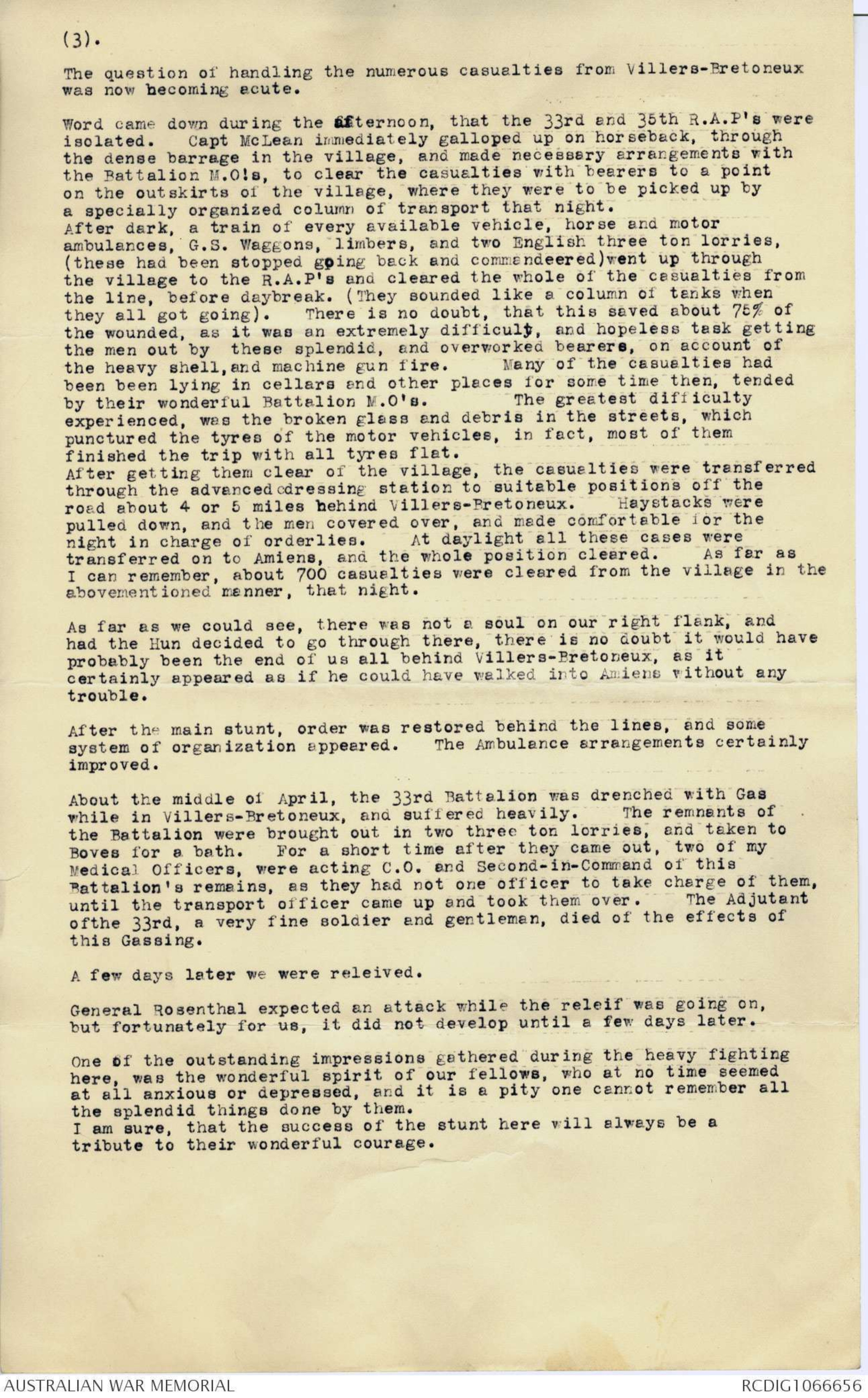
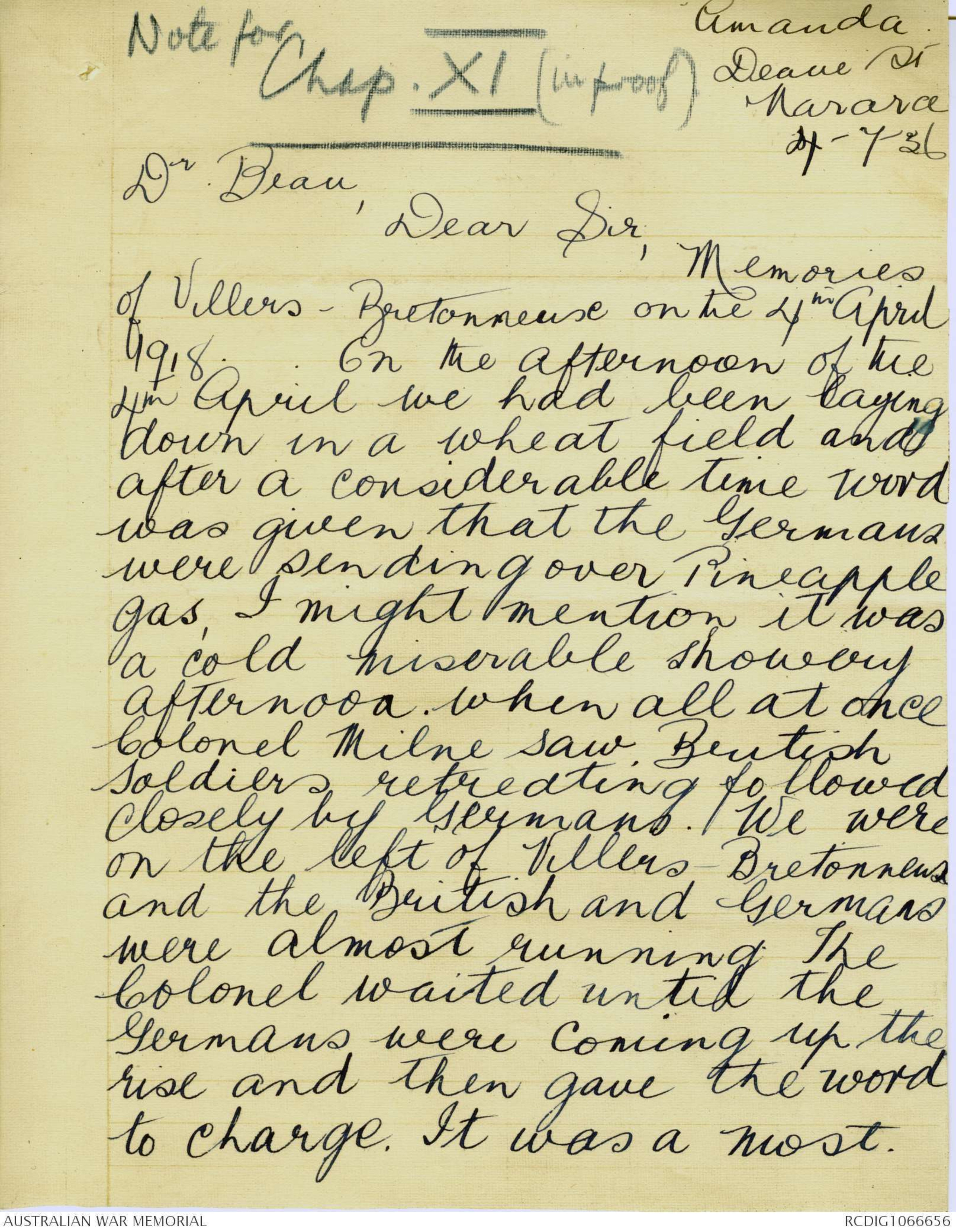
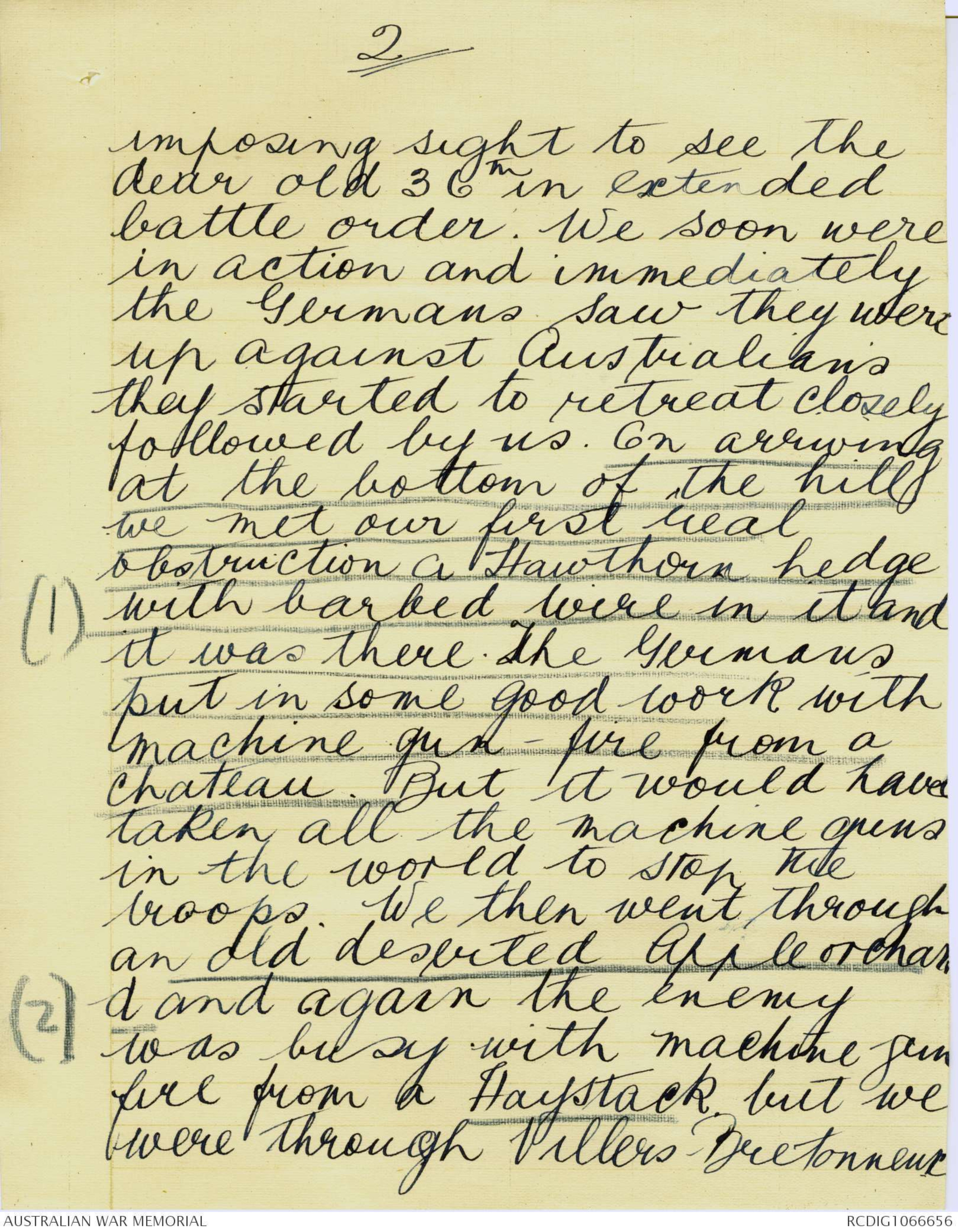
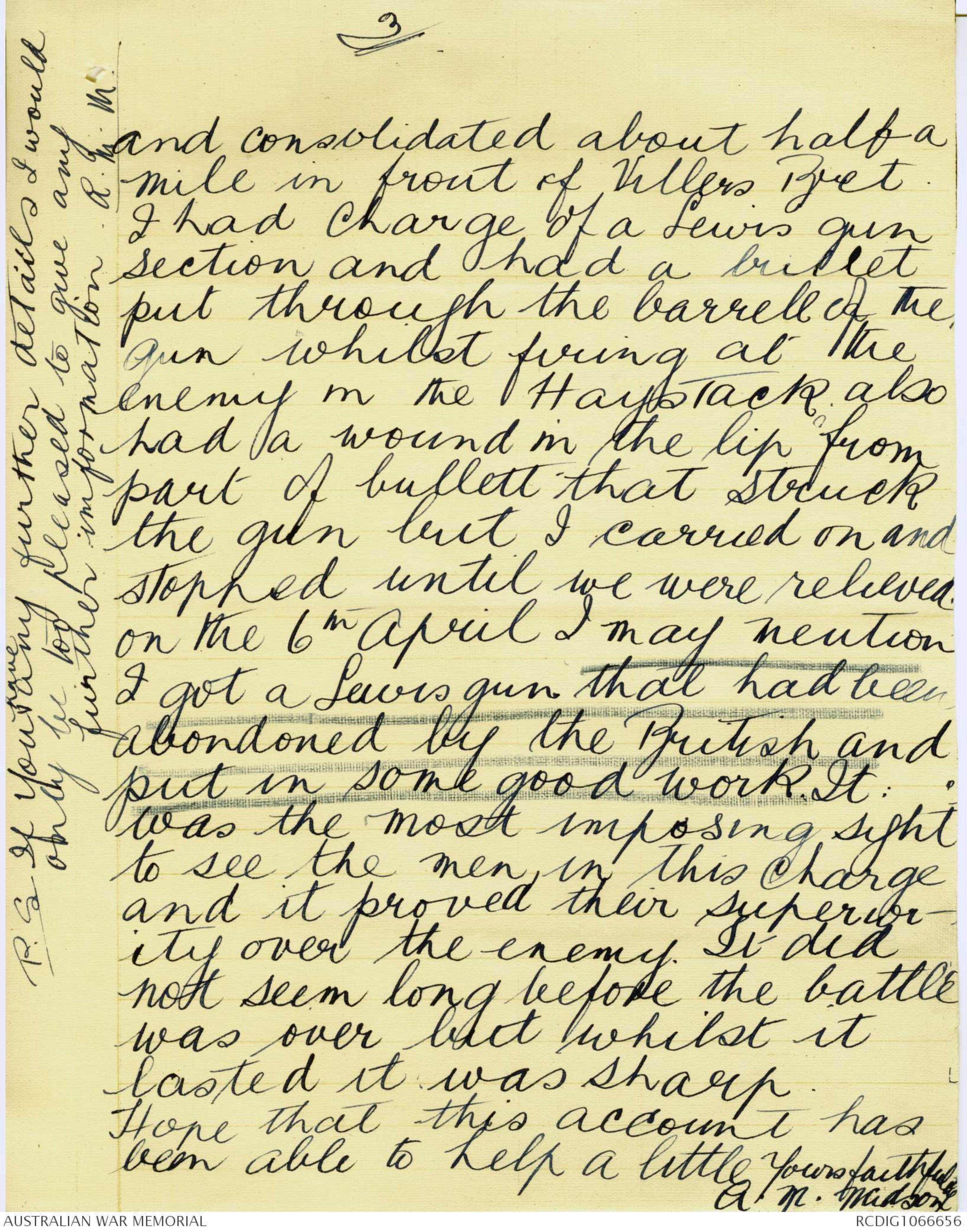
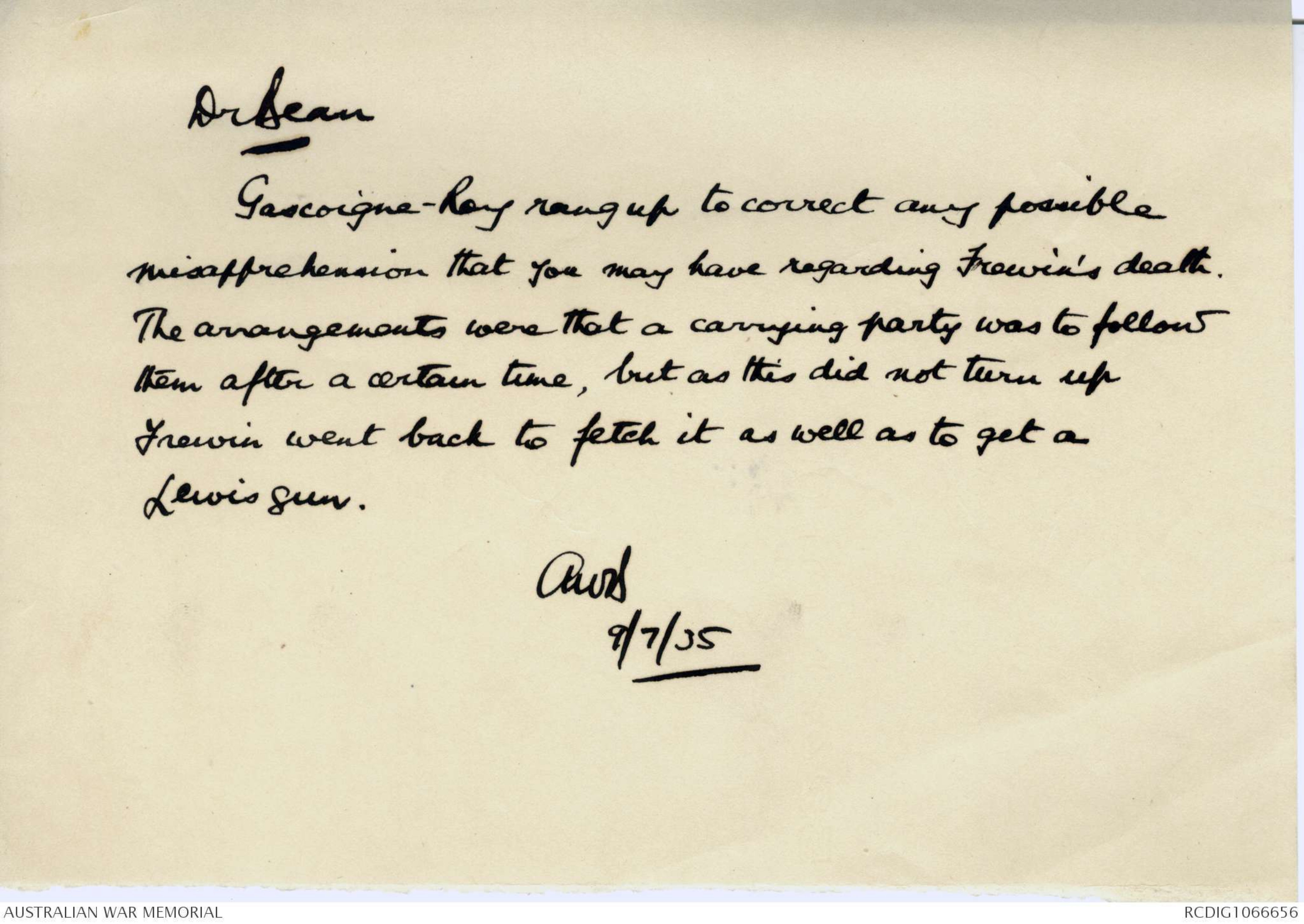
ACACIA AVENUE
LEETON
I should think he would be able to give
you quite a lot of information in regard
to the actual fight should you desire it.
This scrap really was a classic and
I hope you have been able to collect all
the necessary data.
Cheerioh and best wishes for the future.
Alan. F. Folley
HN.V/B ap. 4 1918
VILLERS-)BRETONEUX.
Following are a few facts supplied by ex Sgt Wood of the 35th Battalion,
in connection with the Villers-Bretoneux Stunt. Sgt Wood was hit
during the first day, but has given everything of note he can remember up
to the time of his evacuation.
The attached rough sketch, is given in the hope that it may help to
illustrate the opening phases of the battle on the first day as described
by him.
On the 21st March, the 35th Battalion with the other units of the 9th
Brigade, were at Boulogne.
We moved at short notice to Hazebrouk, and after spending two nights there
we moved at instant notice to a position behind Arras, where after only
a few hours, we were rushed to Doullens.
On the 26th March we moved into Bonney.
On the 27th March we moved into Sailly-le-Sec.
On the 28th March we moved into Cachy, and on the 29th March we moved into Villers-Bretoneux.
A hectic week of packing, moving, and general bewilderment.
The place was fairly quiet at this time, and we assumed our positions in
the village, in comfort. There were an unusual lot of Hun planes about,
but we had no idea of the actual whereabouts of the enemy line.
On April 3rd, heavy shelling commenced.
On Thursday, April 4th, at about 2.a.m. we made our first contact with the
enemy, when two Huns, very drunk, wandered into our posts and were taken
prisoners. At 5.30 a.m. on this morning the Hun laid down his barrage.
I was up with one of the front line posts, of about 40 men, at the time,
(The front line then being only a series of these posts, about 30 to 50
yards apart) when the barrage started. It was intense, and he laid it
on our front line with a striking degree of accuracy for about two hours.
When daylight was advanced, and some of the smoke and dust had cleared a
little, we found dense masses of Huns streaming down the road on our left.
At this time they were also streaming down the Railway line on our right,
in dense formation. One of my chaps calculated them in millions, and it
certainly looked like it.
From the left, they cut into the aerodrome behind and amongst us, and were
apparently right up to the outskirts of the village, when the right
advance along the Railway, were caught by the 36th Battalion and the right
company of the 35th, and definitely checked. On the left the Huns
swarmed over the 33rd and left section of the 35th, and most of the posts
retired to the village.
At about 10 o'clock a.m. a counter attack, by the re-organized 33rd and
35th with some Scots Greys, swept the Hun from the Aerodrome, where some
bitter hand to hand fighting took place. It was during a duel with a
batch of Huns, around one of the huts, that I was hit, and my interest
in the scrap finished. I understand I was carried out with much
difficulty, and was for a time in one of the cellars, with Capt Thomas
(previously mentioned).
I might mention, that the day before the scrap commenced, a batch of Scots
Greys wandered into the village, and finding nobody to report to, attached
themselves to us, and fought with great courage alongside our chaps,
during the counter attack. They suffered heavily, and I have no doubt
that, of those who were with us, very few survived.
Major Connell, (previously mentioned) went right through the whole stunt,
and should be able to supply you with valuable information in connection
with the later phases of the operation.
Diagram - see original document
Rough Sketch of
opening of Villers-Bretoneux
Battle:
(not drawn to scale)
If the Huns had broken through at Villers-Bretoneux, I think we
certainly would have spent the rest of the War in Germany.
Allthough splendid work was done by every man engaged in this stunt,
efforts of General Rosenthal, Lt Colonel Milne, a corporal of Lewis
Guns in the 36th Battalion, and numerous other individuals, are
among the epics of the super-miracle performed, by keeping the Huns
in check here.
A tremendous amount has been said of the 14th and 15th Brigade's
fine work later, but organization was complete at the time of their
stunt, whereas on April 4th and 5th, there was no organization to
speak of, and in cold fact, it was only the wonderful initiative
and commonsense, together with the splendid fighting ability
displayed by the Australians, that won them the day, as on many
occasions they were split up into small batches, and very often
without officers.
It always sticks in my memory as the best stunt ever performed by
the Australians, as they were all on their own, without artillery
support of any kind, and in spite of the tremendous odds, and an
enemy with his tail up, through sheer tenacity, and exceptionally
heavy casualties, hung on, and even at times assumed the offensive.
It is quite certain that had the Hun broken through, he would have
had miles of valuable country, and many important centres entirely
at his mercy, without apparent opposition.
I was an eye witness to the retreat of the English Troops. They
were exceptionally pannicky, and moving back as fast as they could,
without any attempt at order.
Our fellows seemed to be just the opposite, and were eager for the
impending contact with the Hun, allthough they had no idea where
the enemy were, or what was going to happen. The sight of
troops, guns, and all manner of transport moving back in such
disorder, seemed to inspire, and often amuse, more than depress
them.
The Australians had rather a poor opinion of the English troops
at this time, and the impression gathered from what they were now
witnessing was not helpful.
I am just a little hazy after fifteen years, as to the actual dates
but no doubt, these will be available to you.
About March 27th, we had instructions to move over to Gentelles
during the night. At daylight we saw the retreat in full
blast.
That day, the 9th Brigade, moving forward, made contact with the
enemy at Hangard Wood.
A couple of days later, both Cachy and Gentelles were heavily
shelled. Imperial troops came from everywhere, apparently they had
been sheltering in the cellars. They were completely disorganized
- no idea where they were, or what to do. On calling at the
English Divisional Headquarters, (or where they were supposed to be)
in Gentelles, I found they had gone.
Later the Hun attacked Villers-Bretoneux.
How many Divisional Commanders there were controlling the 9th
Brigade, during the period from March 28th to April 5th, I have no
idea, as we seemed to have nobody to report or refer to.
About this time, the Australians moved across from Hangard to
Villers-Bretoneux.
On April 4th, early in the morning, Bois L'Abbe came under severe
bombardment. We, in this wood were not aware of the gravity of the
situation until the afternoon, when the Ambulance Orderlies informed
me, that the Gremans were in Villers-Bretoneux.
(2).
At this time, English troops, guns, ambulances, and all manner of
transport, were still streaming back as fast as they could towards
Amiens.
A few lost 9th Brigade stragglers from the flanks came wandering
in along the road, and as they arrived at the advanced dressing
station, they were collected by us. On General Rosenthal being
informed, he sent Staff Major Paine, to take charge of them, and
lead them back into the scrap in the village.
Thomas and Mailey, the M.O's of the 35th and 33rd Battalions were
on the outskirts of the village, with a cellar full of wounded.
They sent word back to the 37th Battalion H.Q., for information,
but found they were gone. At this stage the Germans were less
than 100 yards away from them, as they had ever-run the 33rd and
35th, and our fellows and Huns were all mixed up together in small
batches in a glorious hurly-burly of private scraps.
Thomas was quite satisfied, that he was going to stay with the
wounded, no matter what happened, and when I saw him a little later,
he only complained of having no cigarettes.
It is possibly common knowledge, the business like way the 36th
Battalion cut into the advancing battalions of the enemy, along the
railway line, and allthough outnumbered by probably 10 to 1,
stopped him, and finally forced him to retreat. I often think
the Hun Commanders thought they had been led into a trap there, but
had they known the real state of things, there is no doubt they
would have probably overwhelmed the shattered remnants of the 9th
Brigade in the village, had they as vigorously persisted.
Lt Colonel Milne was at his Headquarters at the time, when the
C.S.M. came in and reported that they were surrounded. The
Second-in-Command asked Milne "What is to be done Sir", who without
hesitation replied "Well, when in doubt, attack". This, without
question saved the whole situation, as the whole village would have
been completely surrounded in a very short time.
It was as Milne described afterwards:- "Like pushing a full hand
out of a game of poker, with a pair of twos".
Milne told me afterwards, that during the advance, an Officer
dressed in English Uniform, rushed in among the troops of the 36th
calling out "Every man for himself". A corporal of Lewis Guns
without hesitation, promptly shot him with his revolver, and then
turned round and enquired, quite sincerely, "Do you think I did
the right thing". When they later examined the body of this man,
they found his pack filled with straw, and no identification disc:
He was apparently a German.
Sgt W. Wood of the 35th told me, that during the engagement on the
old Aerodrome in front, he saw Capt Sayers being escorted back by
two Germans, when he took off his Tin Hat, brained one of the Huns
with it, knocked down the other one, and made his way back to his
own men, in full view of everybody.
Major Connell (now Member for N.S.W.Parliament, Newcastle) second
in command of the 35th, when things were extremely hot, ran up and
down behind his men singing out "Remember our motto boys", "We
bend but do not break".
The Tent Section of the 9th Field Ambulance were situated in Boves
during this engagement; When Major Smeal found English Troops
deserting the village, he himself went to the English Headquarters
and found them gone also. Before long his Section were the only
troops in the village. As Boves now seemed in danger of being
isolated, it was decided to move to a sounder position along the
Amiens Road. Unfortunately this movement had to be carried out
during the evacuation of the wounded during the night. But, in
spite of this, not one man was left, and no inconvenience caused
the wounded in that sector.
(3).
The question of handling the numerous casualties from Villers-Bretoneux
was now becoming acute.
Word came down during the afternoon, that the 33rd and 35th R.A.P's were
isolated. Capt McLean immediately galloped up on horseback, through
the dense barrage in the village, and made necessary arrangements with
the Battalion M.O!s, to clear the casualties with bearers to a point
on the outskirts of the village, where they were to be picked up by
a specially organized column of transport that night.
After dark, a train of every available vehicle, horse and motor
ambulances, G.S. Waggons, limbers, and two English three ton lorries.
(these had been stopped going back and commandeered) went up through
the village to the R.A.P's and cleared the whole of the casualties from
the line, before daybreak. (They sounded like a column of tanks when
they all got going). There is no doubt, that this saved about 75% of
the wounded, as it was an extremely difficult, and hopeless task getting
the men out by these splendid, and overworked bearers, on account of
the heavy shell, and machine gun fire. Many of the casualties had
been been lying in cellars and other places for some time then, tended
by their wonderful Battalion M.O's. The greatest difficulty
experienced, was the broken glass and debris in the streets, which
punctured the tyres of the motor vehicles, in fact, most of them
finished the trip with all tyres flat.
After getting them clear of the village, the casualties were transferred
through the advanced dressing station to suitable positions off the
road about 4 or 5 miles behind Villers-Bretoneux. Haystacks were
pulled down, and the men covered over, and made comfortable for the
night in charge of orderlies. At daylight all these cases were
transferred on to Amiens, and the whole position cleared. As far as
I can remember, about 700 casualties were cleared from the village in the
abovementioned manner, that night.
As far as we could see, there was not a soul on our right flank, and
had the Hun decided to go through there, there is no doubt it would have
probably been the end of us all behind Villers-Bretoneux, as it
certainly appeared as if he could have walked into Amiens without any
trouble.
After the main stunt, order was restored behind the lines, and some
system of organization appeared. The Ambulance arrangements certainly
improved.
About the middle of April, the 33rd Battalion was drenched with Gas
while in Villers-Bretoneux, and suffered heavily. The remnants of
the Battalion were brought out in two three ton lorries, and taken to
Boves for a bath. For a short time after they came out, two of my
Medical Officers, were acting C.O. and Second-in-Command of this
Battalion's remains, as they had not one officer to take charge of them,
until the transport officer came up and took them over. The Adjutant
ofthe 33rd, a very fine soldier and gentleman, died of the effects of
this Gassing.
A few days later we were releived.
General Rosenthal expected an attack while the releif was going on,
but fortunately for us, it did not develop until a few days later.
One of the outstanding impressions gathered during the heavy fighting
here, was the wonderful spirit of our fellows, who at no time seemed
at all anxious or depressed, and it is a pity one cannot remember all
the splendid things done by them.
I am sure, that the success of the stunt here will always be a
tribute to their wonderful courage.
[*Note for Chap. XI (in proof.) *]
Amanda
Deane St
Narara
4-7-36
Dr. Bean,
Dear Sir,
Memories
of Villers-Bretonneux on the 4th April
1918. On the afternoon of the
4th April we had been laying
down in a wheat field and
after a considerable time word
was given that the Germans
were sending over Pineapple
gas, I might mention it was
a cold miserable showery
afternoon when all at once
Colonel Milne saw British
Soldiers retreating followed
closely by Germans. We were
on the left of Villers Bretonneux
and the British and Germans
were almost running. The
Colonel waited until the
Germans were coming up the
rise and then gave the word
to charge. It was a most
2
imposing sight to see the
dear old 36th in extended
battle order. We soon were
in action and immediately
the Germans saw they were
up against Australians
they started to retreat closely
followed by us. On arriving
at the bottom of the hill
we met our first real
obstruction a Hawthorn hedge
with barbed wired in it and
[*(1)*] it was there. The Germans
put in some good work with
machine gun - fire from a
chateau. But it would have
taken all the machine guns
in the world to stop the
troops. We then went through
an old deserted apple orchard
[*(2)*] and again the enemy
was busy with machine gun
fire from a Haystack but we
were through Villers-Bretonneux
3
and consolidated about half a
mile in front of Villers Bret.
I had charge of a Lewis gun
section and had a bullet
put through the barrell of the
gun whilst firing at the
enemy in the Haystack also
had a wound in the lip from
part of bullett that struck
the gun but I carried on and
stopped until we were relieved.
On the 6th April I may mention
I got a Lewis gun that had been
abandoned by the British and
put in some good work. It
was the most imposing sight
to see the men in this charge
and it proved their superiority
over the enemy. It did
not seem long before the battle
was over but whilst it
lasted it was sharp.
Hope that this account has
been able to help a little
Yours faithfully
A.M. Midson
[*P.S. If you ^have any further details I would
only be too pleased to give any
further information. A.M.M.*]
Dr Bean
Gascoigne-Roy rang up to correct any possible
misapprehension that you may have regarding Frewin's death.
The arrangements were that a carrying party was to follow
them after a certain time, but as this did not turn up
Frewin went back to fetch it as well as to get a
Lewis Gun.
AWM
9/7/35
 H.Boutell
H.BoutellThis transcription item is now locked to you for editing. To release the lock either Save your changes or Cancel.
This lock will be automatically released after 60 minutes of inactivity.